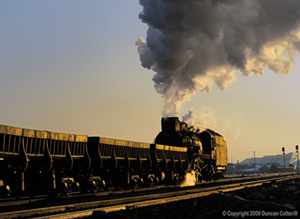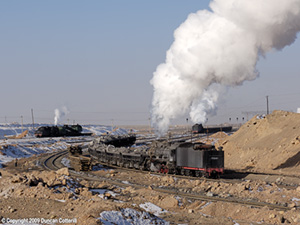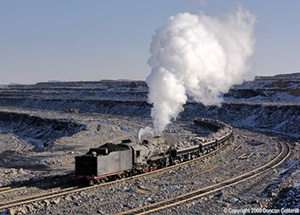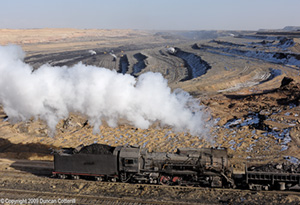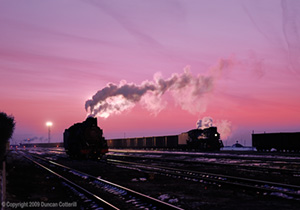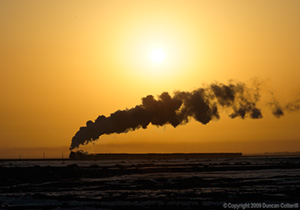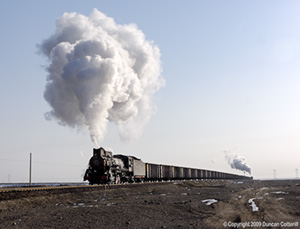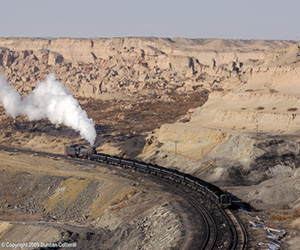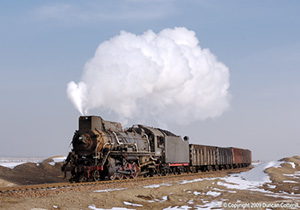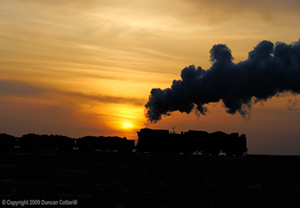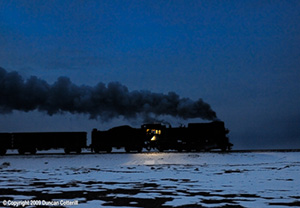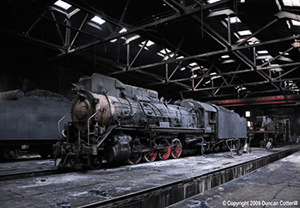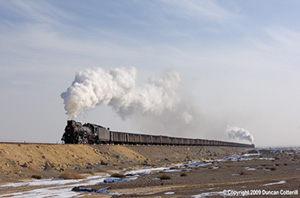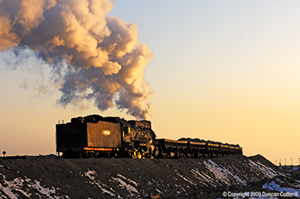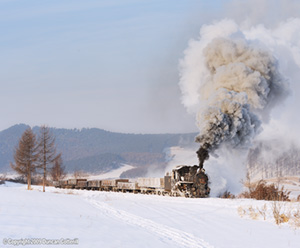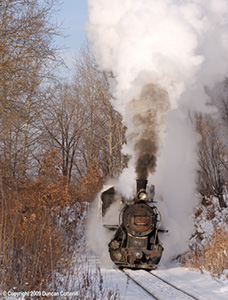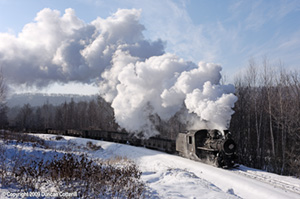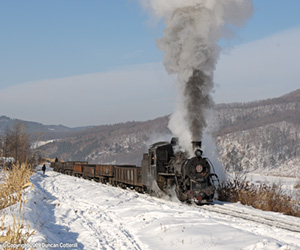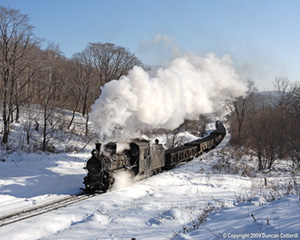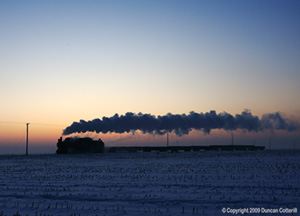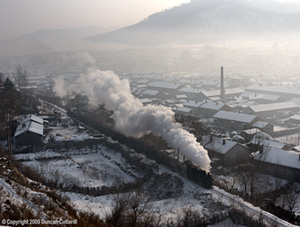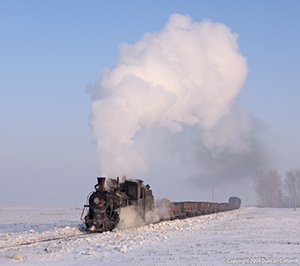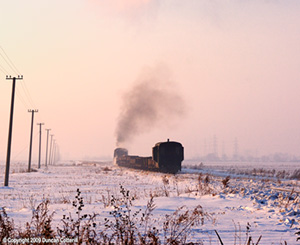Coal Lines East and West
18 November - 01 December 2009
Report by Duncan Cotterill
Introduction
It was November once again and time for the first of this winter’s photographic trips to China. The days when steam locomotives were easy to find are long gone and the best locations are often far from each other. On this trip we set out to visit two of the furthest apart, the opencast coal mine at Sandaoling in the north-western province of Xinjiang and the narrow gauge coal railway at Huanan in eastern Heilongjiang. These are two very different operations yet they share some common features beyond the fact that they both haul coal, most notably the use of banking engines.
I was joined by Peter Breeze and our long-time friend Sun Xiaolan for what turned out to be a very rewarding trip, although it all appeared on the verge of going horribly wrong about half way through.
UK to Sandaoling
Peter and I left the UK on 18 November 2009, flying with Air France from the UK to Beijing via Paris. On arrival at Beijing we met Xiaolan and flew on to Wulumuqi (Urumchi/Urumqi) on CZ6902, arriving in the early evening. It took around 30 minutes to transfer to Wulumuqi station, where we were due to catch train K9782 at 23:08 to Hami. There were several heavily delayed trains on the departure board including T194, which was 29 hours 28 minutes late, but there was no sign of a problem with our train until shortly before departure when an indeterminate delay was announced. K9782 then disappeared off the departure board, never to reappear. This was not the most confidence inspiring thing that could have happened. We eventually left around 3 hours late and lost a few minutes more before we arrived in Hami just after 09:00 on the morning of 20 November. From Hami, we transferred by road to Sandaoling, where we stayed in the Sanhe hotel in the centre of town. Even though we had official permission to visit the railway, the police arrived to check our passports about 5 minutes after we’d checked in.
Sandaoling Coal Railway
(20-24 Nov 2009)
There were no diesels at Sandaoling and, so far as I could tell, there were none expected imminently. The railway appeared to have an aspiration to buy some diesels but they didn’t seem to be able to find what they want for the price they were willing to pay. Later information suggests that four diesels may have been purchased. Everything was still 100% steam worked when we were there although the engines didn’t appear to be in as good condition as they were four years ago.
There had been a number of changes over the past few years, some good, some bad. The eastern end of the opencast mine appeared to have been abandoned and was being used to dump spoil, brought in by lorry from the west end of the mine. Spoil train operations at the west end didn’t seem to have been affected and trains still ran to the tips at Xibolizhan every 5 to 10 minutes. Coal trains ran at 30 to 60 minute intervals, similar to before, and exited the pit at the east end, en-route to the washery at Xuanmeichang. All spoil and coal trains ran with the loco coupled chimney to the wagons and propelled out of the pit so spoil and coal trains had engines at opposite ends and could easily be distinguished within the pit.
Around a dozen locos still congregated at Xibolizhan for the morning shift change at 09:00 although Dongbolizhan could be very quiet with only a couple of locos present. The “passenger train”, consisting of a couple of boxcars and a control coach continued to run at shift change from Dongbolizhan to Xibolizhan then go down into the pit and then up to the spoil tips before returning to Dongbolizhan. It was worked by an SY on the two days we saw it.
On the surface system, traffic levels had increased significantly since our previous visit. There were more trains running to and from the deep mines at Beiquan, which appeared to produce a similar volume of coal to the opencast pit, and more trains on the connecting line between Nanzhan and the CR main line at Liushquan. The trains to and from Beiquan were of limited interest as they ran uphill to the mines, tender-first, and returned downhill, chimney first. The only uphill, chimney first section was the first few hundred yards from Beiquan Yijing, after which it was downhill all the way.
The line from Liushuquan was much better with chimney-first locos working the empties on a route that's uphill virtually all the way. Even the section in the middle of the line from the level crossing to the river bridge that looks downhill is actually uphill but not as steep as the rest of the line. The scenery isn't great but the spectacle of a pair of JS being flogged on a long train of empties more than made up for that. Most trains ran with a loco at each end but we also saw a number of workings of up to 35 wagons, hauled by a single JS. Some trains, generally the heaviest ones or single headers approaching the 35 wagon limit, stopped for a blow-up just short of the level crossing midway along the line. On a good day, there were trains from Liushuquan at 2 to 3 hour intervals but gaps could be much longer if CR were slow delivering empty wagons. Chasing was easy on the parallel road, allowing 2 or 3 shots of each train without any difficulty.
Locos seen in use :
Opencast Mine : JS 6205, 6261, 6436, 8027, 8040, 8076, 8078, 8081, 8167, 8173, 8188, 8190, 8193, 8194, 8195, 8221, 8222, SY 1304, 1593, 1729*1.
Surface System : JS 6204, 6208, 8053, 8314, 8358, SY 1729*1.
Workshops : JS 8195 (washout), 8189 (cold serviceable), 6224 (overhaul), 8366*2 (heavy overhaul).
Dumped / Stored : JS 5455, 6203*3, 6206*4, 6209, 6210*5, 6213, 6223, 6259, 6430, 8055, 8077*6, 8080, 8089, 8197, 8225, 8368*7, 8384, SY 0092, 1718.
*1 SY 1729 was the only loco we saw on both systems.
*2 Thought to be JS 8366 but not positively identified.
*3 JS 6203 had air receiver stamped 6028,
*4 JS 6206 had failed a few days earlier (broken eccentric).
*5 JS 6210 had air receiver stamped 6260 and 1983 plates,
*6 JS 8077 had air receiver stamped JS 8118,
*7 JS 8368 had air receiver stamped 8367 and 1985 plates.
The only loco we expected to see but didn’t was SY 1720 but it was seen twice by other visitors.
CR Wulumuqi - Hami
Most of the passenger trains from Hami to Wulumuqi and v.v. were DF11 hauled but those going towards Korla appeared to be worked by standard green DF4Bs. We had DF11 0221 on train 1043 from Hami to Wulumuqi on 24 November. The loco worked in from the east, so probably ran through from Jiayuguan to Wulumuqi. The frequent freights passing Liushuquan were hauled by DF4C or DF4B locos. The line is currently being electrified and poles have already been erected from Hami to west of Liushuquan but no wiring has yet taken place.
Sandaoling to Huanan
This was always going to be a tricky journey. In theory it was possible to leave Sandaoling in the evening and after travelling for a night, a day and the following night, arrive at Huanan early on the second morning. That was what we attempted to do but timing was critical and some of the connections en route were fairly tight, particularly the first one in Wulumuqi.
The first part of the journey went smoothly enough. We left Sandaoling just after sunset on 24 November and travelled by road to Hami. Train 1043 left Hami a few minutes late but deposited us in Wulumuqi on schedule at 07:00. Despite losing 20 minutes trying to locate our driver at the station and then encountering icy conditions on the road to the airport, we were there before 08:00, in plenty of time to check in for our 09:10 flight to Beijing. That was where our troubles really began. Our flight was shown as delayed until 12:30 so we had to rebook our onward flight from Beijing to Harbin and cancel our train tickets from Harbin to Boli.
As it got light, it became clear why there were delays. Wulumuqi was blanketed in thick fog. By 09:30 it was starting to lift and a few flights got away but then the fog descended again and stayed put for the rest of the day. Nothing arrived or left and our 12:30 departure soon became 14:00 and there it remained until around 17:00 when it changed to 20:00. Around 19:30 it changed again to 22:30 but shortly after that the flight was cancelled. After much confusion and going from desk to desk, we managed to retrieve our bags and Hainan Airlines rebooked us on the following day’s CA1298, an Air China flight departing at 18:50. Then it was just a case of finding a hotel and waiting to see what the following day would bring.
Thursday 26 November dawned dull and foggy. We even started thinking about whether to abandon our plans to visit Huanan and just make sure we got back to Beijing in time for our flight back to the UK on 1 December. Although the visibility seemed no better than the previous day, we did hear a couple of flights taking off, out of the 20 or so that were scheduled. The TV weather forecast wasn’t very helpful and just said Wulumuqi was cloudy and there would be some sun in the afternoon. Quite frankly, we didn’t believe a word of it. The fog looked set in for the day again and we didn’t have much hope that our 18:50 departure would actually fly.
When we left for the airport at 14:00, the visibility had improved slightly and our hopes began to rise. A steady trickle of planes was actually landing and taking off. Then Xiaolan got confirmation that the outward leg of our flight, CA1297, was in the air, although it was expected to land about 90 minutes late. We got our onward flights from Beijing to Harbin rescheduled for early the following morning and headed for the check-in. We would soon be on our way, or so we thought.
Eventually we got to the front of a very long check-in queue where we were told that we weren’t on the list for CA1298 and we should take the matter up with Hainan Airlines. All hopes of getting away suddenly faded, taking with them any chance of actually getting to Huanan. There seemed to be some sort of petty dispute between the airlines and Air China was retaliating for a lack of co-operation from Hainan Airlines elsewhere. Of course it was the passengers that suffered, not the airlines.
Back at the Hainan Airlines ticket desk nothing happened for a long time and then, suddenly, everything changed. With no warning, Xiaolan ran towards the check-in desks and we followed. A long exchange with a Hainan Airlines official followed and then boarding cards appeared, baggage was checked in and we were heading through security to find our flight, not CA1298 but CA1296, originally due to depart at 09:30. The plane was already at the gate so we hurried to board. With so many people desperately trying to leave, it came as a bit of a surprise to board a fairly empty 737-800. Over the next hour or so, more passengers arrived in ones and twos until eventually the doors were closed. Shortly after 19:00, and still only 75% full, we pushed back and, after another 30 minutes waiting for a slot, took off for Beijing.
The rest of the journey to Huanan was fairly routine. We arrived at Beijing just after 23:00 and found a hotel for the night. The following morning we flew to Harbin on CA1603 at 08:10, arriving around 10:00. After a taxi ride into town, we took train K7007 at 13:44 to Jiamusi and then a freezing cold and tediously slow taxi to Huanan, arriving around 21:30. Our one day journey had taken just over three days but we had finally arrived. We stayed at the Huanan Hotel in downtown Huanan.
CR Harbin - Jiamusi
After seeing no sign of the NYJ1 diesel units in 2008, it was a bit of a surprise to find that both train K7007 to Jiamusi and train K7003 to Mudanjiang were NYJ1s on 27 November. All the other passenger trains we saw en-route were hauled by either passenger DF4B or DF4D. Freights were mainly DF4C hauled although a few DF4B were also seen.
Huanan Coal Railway
(28-30 Nov 2009)
Huanan was running fairly normally but with only three locos available and poor reliability, there were only two engines in traffic much of the time we were there. On our first day, 28 November, only numbers 004 and 168 were in use. The first daylight train left Huanan around 06:30 and there was a return working from Lixin at 10:00. The next train out of Huanan didn’t leave until after 14:00 and passed us at Tuoyaozi just as we were leaving, some time after sunset.
29 November started in a similar way with trains at 08:00 from Huanan and 11:30 from Lixin. Hovever there was now a third engine available, 011, and another train left Huanan at around 11:30 and crossed the loaded train at Xiahua. We even managed to get a third train of empties a few km east of Huanan at sunset.
The three loco service continued on 30 November with trains leaving Huanan and Lixin around 08:00 but there was no 12:00 departure from Huanan and the 12:00 from Lixin returned without crossing anything. After chasing it back to Huanan, we had to leave for Mudanjiang and our flight back to Beijing.
We were told that there is now real difficulty in getting hold of spare parts to keep the engines going and none of the three working locos was in good condition. Stops for a blow-up were frequent and getting ahead of a train for a second shot was often possible, even on foot. The weather was cold and relatively clear on the first few days but rather mistier on the third day. We didn’t see the railcar on any of the three days we were at Huanan but on 30 November, the 08:00 from Huanan and 12:00 return conveyed a brake van and there appeared to be some passengers aboard. There wasn't time for it to have gone any further than Lixin.
Huanan is still well worth a visit and the risk that it won’t be running shouldn’t put anyone off. After all, with Jixi a couple of hours drive away, you won’t be stuck for something to do.
Locos in use :
004, 011, 168CR Huanan Area
Two CR freights were seen at Huanan, both hauled by standard, green DF4Bs. On the way back to Mudanjiang we overtook a coal train, probably from Qitaihe, and hauled by a DF8.
Huanan to UK
In comparison with the journey from Hami, travelling back to Beijing was a total anticlimax. We left Huanan just before 15:00 on 30 November 2009, going by road to Mudanjiang Airport where we caught flight HU7104 to Beijing, departing and arriving a few minutes early. After a night in the Capital Airport Hotel, we returned to the airport for our flights back home, Xiaolan to Dalian (after another delay caused by fog), Peter to Manchester and me to London.
Comment
We had been to Sandaoling before in November 2005 but the weather was a lot warmer then and the locos’ exhausts disappeared by lunchtime each day. There was also much less activity on the Liushuquan - Nanzhan section in 2005. Overall, our results from this trip were much improved although we did better for light and wind in the early morning at Xibolizhan on the previous trip.
It was difficult to tell the status of locos in the store/dump at Sandaoling but a few have disappeared since our previous visit. JS 6206, which had failed with a broken eccentric a few days earlier looked little different to some engines that had been there for years. The good news is that heavy repairs are continuing and there should be a significant level of steam activity for the next year at least.
Despite the loss of two days, our visit to Huanan was also very rewarding. Three previous winter trips in 2006, 2007 and 2008 had produced little in the way of good results with bad weather, loco failures, a shortage of diesel fuel for the loaders and a shortage of coal to transport all preventing us from getting the pictures we wanted. Although we only had 2.5 days there, rather than the 4.5 days planned, we still got more good shots than on our previous three trips combined. Clear weather and a favourable wind helped enormously and the long gaps between trains at certain times weren’t too disastrous as the trains ran at good times for the light.
With fewer places running steam, it would be natural to assume that the remaining centres would be busier, with more enthusiasts intent on visiting the last few quality locations. Not a bit of it. In Sandaoling we saw quite a lot of Wolfgang Klein and Peter Semmelroch and briefly met Hans Schaeffer and Ron Olsen. Someone else turned up at Nanzhan on our first afternoon but couldn’t be bothered getting out of their van to say hello. We never saw them again. At Huanan, we met Jeff Cartledge and Colin Wreyford as well as a group of Chinese photographers from Jiamusi, out for a day trip, but that was all.
Although Chinese steam is coming to an end, it hasn’t finished yet and there are still some great operations to visit and spectacular sights to see. Anyone contemplating a visit this winter should definitely go before it’s too late. Next year, you will still be able to silhouette the empties from Liushuquan against the sunrise but it may have a DF4 on the front rather than a JS. Whether Huanan will be running at all by this time next year is very uncertain. Seize the moment and go now.
